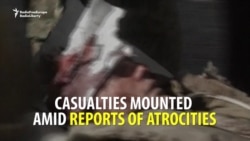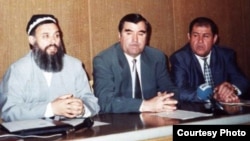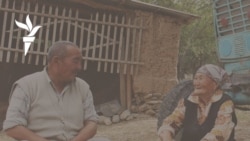
On June 27, Tajikistan marks the 20th anniversary of the signing of the Tajik Peace Accord that ended a five-year civil war there.
The man who will be taking much of the credit for achieving peace in Tajikistan is President Emomali Rahmon, aka "Asosguzori sulhu vahdati milli -- Peşvo'i millat" ("Founder of Peace and Unity -- Leader of the Nation.")
The first part of this title, bestowed upon Rahmon by Tajikistan’s parliament in December 2015, seems overly generous.
Rahmon was indeed a part of efforts to reach peace in Tajikistan, but he was just one of many people involved in the process.
Civil war broke out in May 1992 and by year’s end conservative estimates put the death toll at more than 20,000. Half a million people, nearly one-tenth of Tajikistan’s population at the time, had lost their homes. More than 100,000 citizens of the country had fled to Afghanistan.
The country was falling apart and even the combatants could see such devastation could not continue much longer.
The United Nations arranged peace talks; appointed a special representative for Tajikistan, Ramiro Piriz-Ballon, to push these talks forward; and created the UN Mission of Observers in Tajikistan (UMOT), military observers sent to monitor the warring factions’ compliance -- or more often record their noncompliance -- in respecting agreements reached at the peace talks.
WATCH: Twenty Years Later: The Tajik Civil War And Its Aftermath
The first round of talks between the Tajik government and battlefield opponents the United Tajik Opposition (UTO) took place in Moscow in April 1994 after some shuttle diplomacy by Russian First Deputy Foreign Minister Anatoly Adamshin, who had been traveling between Dushanbe and Tehran, where the UTO leadership was based.
Also attending were representatives of Kazakhstan, Kyrgyzstan, Turkmenistan, Uzbekistan, Iran, Pakistan, Afghanistan, the Organization for Cooperation and Security in Europe (known as the Council for Security and Cooperation in Europe until December 1994), and the Organization of the Islamic Conference.
This first meeting set the agenda for later talks. The two sides would work on a political settlement, address the problems of refugees and internally displaced people, and the structure of a future government in Tajikistan. Kazakh President Nursultan Nazarbaev later proposed establishing a National Reconciliation Forum, which became the National Reconciliation Council.
The talks were almost derailed entirely in mid-July 1994 when Tajikistan’s parliament announced that a referendum on a draft constitution and a presidential election would be held simultaneously later that year.
The UTO stepped up its military campaign in response.
UN Secretary-General Boutros Boutros-Ghali threatened to suspend the UN’s participation in further talks.
The warring parties agreed to return to the negotiating table.
A second round of talks were held in Tehran in September 1994; and a third round in Islamabad in late October and early November of that year -- both rounds resulting in agreements for cease-fires that never took hold.
But higher officials from both sides attended the second and third round of talks, showing they were gaining in importance. First Deputy Chairman of Tajikistan’s Supreme Soviet Abdulmajid Dostiev led the government delegation. Hoja Akbar Turajonzoda, the First Deputy Chairman of the Islamic Renaissance Party of Tajikistan (IRPT), the backbone of the UTO, led the opposition’s delegation.
On November 6, 1994, the new constitution was approved in the referendum. One of the changes was the reinstatement of the position of president, which had been removed in changes to the constitution in 1992.
Emomali Rahmon, who, as speaker of parliament had been head of state in Tajikistan since November 1992, was elected to the newly recreated post of president.
It was, however, the closest presidential election in postindependence Central Asia, with Rahmon receiving 59.5 percent of the vote and his challenger, Abdumalik Abdullojonov, a former prime minister and a former ambassador to Russia, receiving 34.7 percent, despite accusations of vote-rigging and other campaign violations.
The fourth round of peace talks was due to start in January 1995 in Moscow but was postponed after the Tajik government announced that parliamentary elections would be conducted in late February 1995.
The presidential and parliamentary elections would become a major impediment to peace talks for months, because one of the key issues being discussed was a power-sharing agreement that would give the UTO places in Tajikistan’s government.
Government representatives at talks in 1995 and 1996 would point to the presidential and parliamentary elections as popular mandates that could not be revoked to give the UTO government positions.
Peace talks became more complicated. The fourth round did finally happen in Moscow in April 1995, but the next round was postponed several times due to disagreement over the venue.
The fifth round opened in Ashgabat, Turkmenistan, at the start of December 1995 with Turkmen President Saparmurat Niyazov calling on the warring factions to share a dinner table and eat the "plov of peace."
The opposition left on the first day, claiming Russian warplanes had bombed UTO positions in the Garm and Pamir regions. Talks were optimistically delayed until mid-January 1996, but it soon became apparent that that date would not be met.
Russia stepped in and put pressure on the Tajik government. In late January 1996, President Boris Yeltsin spoke about Russia’s commitment to Tajikistan, the Russian troops deployed there, and the financial help Russia was providing Tajikistan.
Yeltsin said Russia was "tiring of holding Tajikistan in its arms."
Talks in Ashgabat resumed on January 29, 1996, but the government’s new chief negotiator, Foreign Minister Talbak Nazarov, said negotiations were near collapse.
Peace negotiations were continually postponed. The Tajik peace talks in Ashgabat would not conclude until July 1996, and in between January and July Iranian Foreign Minister Ali Akbar Velayati and Russia Foreign Minister Yevgeny Primakov made separate trips to Ashgabat in an attempt to keep negotiations going.
While the Tajik government and UTO were engaged in fighting each other and in talking about peace, events inside and outside Tajikistan were occurring that would reinvigorate efforts toward a resolution of the civil war.
Four years into the war, there were individuals on both sides who had grown powerful and were increasingly operating independently. Mahmud Khudaiberdiev and the Sadirov brothers, who were mentioned in an earlier Qishloq Ovozi, are examples.
Rahmon’s challenger in the 1994 presidential election, Abdumalik Abdullojonov, had teamed up with two other former prime ministers -- Jamshed Karimov and Abdujalil Samadov -- to form the National Revival Movement (NRM) in spring 1996 and the new group was rapidly gaining popularity, especially in the northern Sughd region where some 40 percent of Tajikistan’s population lived.
The movement’s supporters were calling for the NRM to have seats at the peace negotiations.
And at the end of September 1996, the Taliban captured Kabul and continued driving northward, to areas where the UTO had established bases and where tens of thousands of refugees from Tajikistan were sheltering.
Russia, in particular, was worried the Taliban might reach an agreement with the UTO at a time when the latter was making battlefield gains in the mountains of central Tajikistan.
In December 1996, Rahmon traveled to Khostdekh in northern Afghanistan to meet face-to-face with UTO leader Said Abdullo Nuri.
Peace talks resumed in Tehran in early January 1997 and would move between Tehran and Moscow as the Tajik government and UTO worked out an agreement that would, among other things, give 30 percent of the places in government to the UTO; create the National Reconciliation Commission to propose constitutional amendments and prepare for parliamentary elections; and declare an amnesty for opposition members and a legalization of the parties that made up the UTO.
Rahmon and Nuri, and UN special representative for Tajikistan Gerd Merrem (who replaced Piriz-Ballon in June 1996) signed the agreement in Moscow, with the Russian and Iranian presidents looking on.
It had taken eight rounds of negotiations and several dozen other meetings in Kazakhstan, Kyrgyzstan, Turkmenistan, Uzbekistan, Afghanistan, Pakistan, Iran, and Russia to reach a peace agreement.
Scores of diplomats had been involved.
Individual countries and international organizations would continue to help Tajikistan in the years that followed to help alleviate the damage done to the country during the civil war and prevent the conflict from returning.









